“If you fail to plan, you plan to fail.” Or in our case, if you fail to web design business plan, you plan to web design business fail?
I don’t think that works the way I thought it would, but you get the picture, right? 😂
In all seriousness, I think a lot of folks who are trying to learn how to build a web design business get caught up early on in things that are bright and shiny like how to find clients or even how to be a better developer.
And, don’t get me wrong. Those are great things to learn. But, if you’re not careful, you’ll be 5 years in asking yourself, “How did I get here?” And, you might have to start all over again.
That’s why it’s important that you take a step back and look at things from a 10,000 foot perspective.
You ask yourself some essential questions in order to have a web design business that stands the test of time and navigates the inevitable ups and downs.
You figure out what your growth trajectory is and how you plan on getting there.
When you do that you avoid the pitfalls that are 100% going to come on your journey to building a successful web design business.
And, it’s also pretty essential if you ever try to get a loan or investment.
So, how do you build a web design business plan that not only gets you to your goal fast BUT does it in a way that’s sustainable?
Great question. Luckily, that’s exactly what this article is covering. Let’s dive in.
What is a Web Design Business Plan
Section Summary
- Web Design Business Plan Definition: A document outlining the company’s structure, market summary, team roles, services, marketing strategy, and growth projections.
- Purpose: Not just for loans but to clarify strategy and long-term goals
Before we get too deep in the weeds and the “how tos” let’s make sure we’re all on the same page here and clarify what we’re talking about.
A web design business plan is a document you create that in general talks about 5 things:
- The company itself
- A brief summary of your competition and the state of the market
- The people who are in your company and what their roles are
- What it is you’re selling
- Your marketing strategy
- What your projections for income and growth are
Most of the time people only really sit down to write business plans when they’re trying to get a loan or funding. But, I tend to see a web design business plan as more than just a tool to get a loan or sell yourself.
Honestly, a business plan just helps you get whatever is in your head about your strategy and long term goals out into the open. You’d be surprised how much clarity that brings AND how much it’ll help you see the flaws in your thinking.
How Do You Write a Web Design Business Plan?
Section Summary
- Methods: Traditional detailed plan vs. lean one-page plan.
- Recommendation: Start with market research to shape services and marketing strategy.
There’s not really a right or wrong way to write a business plan.
But there are two pretty popular methods. You could go the more traditional route OR you could opt for a lean business plan.
The traditional route is more in-depth. It tends to be a few pages long.
The lean business plan is kind of like a one page snapshot. Folks that opt for a lean business plan tend to want the ability to lay it all out there quickly and simply.
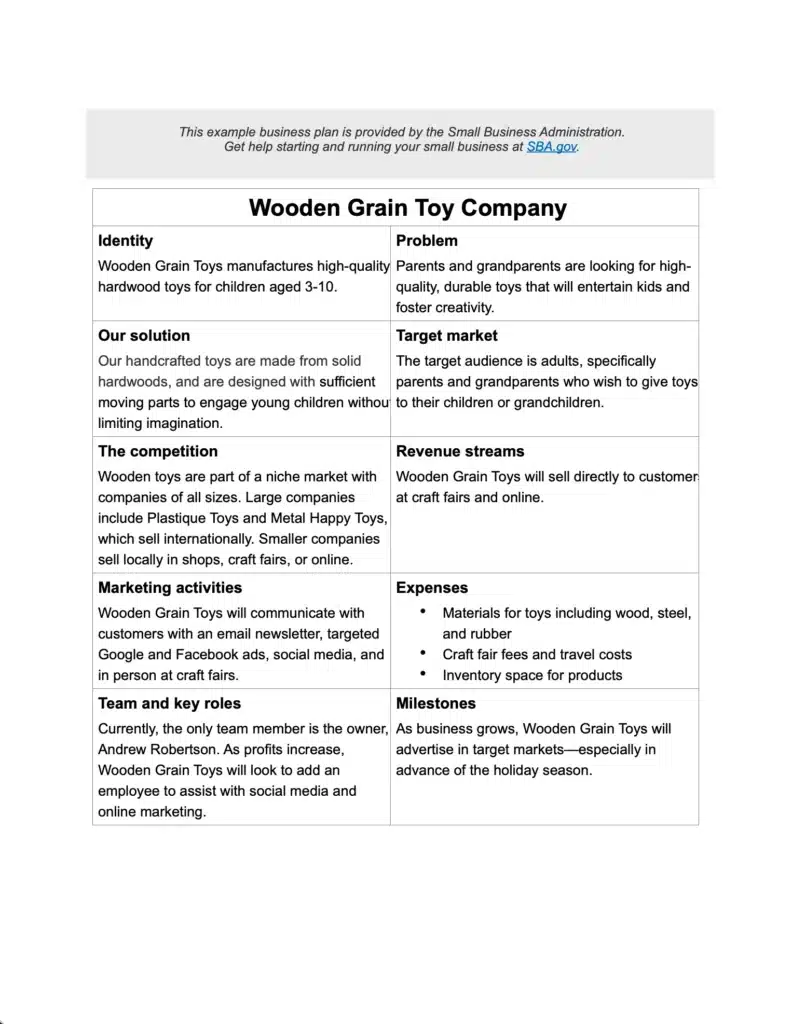
This might be a great option if you’re ever in the scenario where you’ve got to do an elevator pitch.
Personally, I think it’s a good idea to start with some market research before you start writing up details about what you’re selling and how your going to market yourself.
Why? Because good market research will really help to shape what it is you do and how you do it.
So, step 1: Market Research.
1. Market Research
Section Summary
- Tools: Google, Google Keyword Planner, Chat GPT, and interviews.
- Goals: Understand competitors, identify market gaps, and define customer specifics.
Market research for your web design business plan could go all the way from a simple google search to an in-depth data analysis from the U.S. census.
Personally, I think it’s best to stick to pretty generic research unless you have the money to get really refined quantitative data.
The good news is you can still get a decent amount of information about your market even if you don’t have the kind of money to pay a company like McKinsey to help you out.
First, let’s look at WHERE you can do the research you need to do for your web design business plan.
Using Google for Market Research
The first and probably most obvious option for doing market research is doing a little Google searching.
A simple “web design businesses near me” will pretty quickly give you an idea for all the web design companies within a 20 mile radius of you.
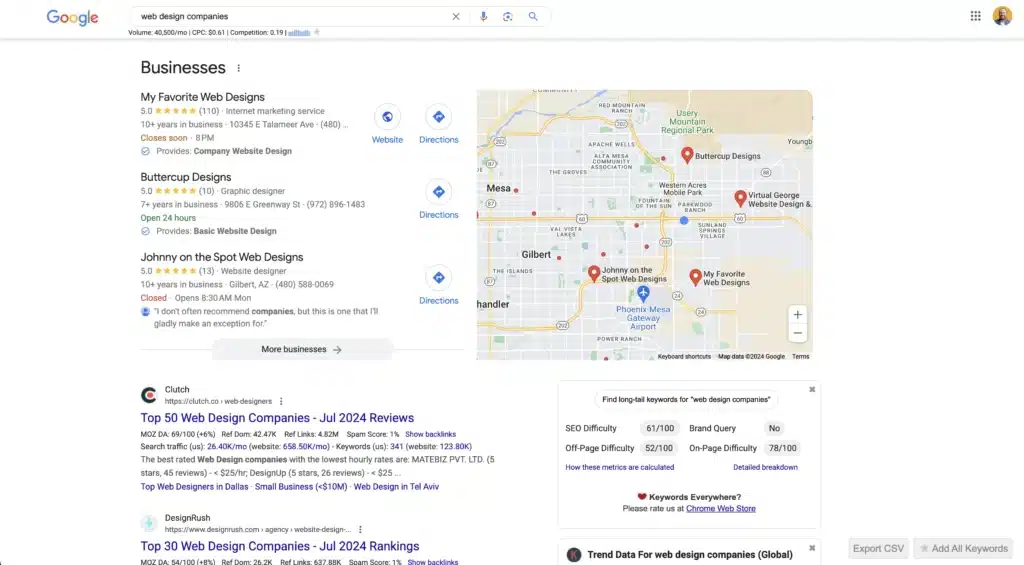
From there you can start snooping around. See what other web design businesses are offering as services AND even see if they list their prices.
If they don’t, you could always ask!
Hear me. Don’t pretend to be a potential client and reach out to them. That’s a jerk move.
Getting an email from a potential client is such an amazing feeling. But, if that “potential client” happens to be a competitor who just wants the inside scoop 🤬
Most people will probably be fine sharing their prices. If they’re not, no harm no foul…move on.
Using Google Keyword Planner for Market Research
Another fun Google tool that’s typically used in the world of SEO and PPC ads is Google’s Keyword Planner.
Why would you use an SEO tool when you’re doing market research for your web design business plan, Chris?!
Great question. But, you don’t have to be so saucy.
The answer is that this lovely little tool also gives you the trends Google is seeing in search volume. As well as how competitive that search phrase is.
With that kind of information you could start to see specific markets that have an increase in interest without a lot of competition. That’s basically the golden egg of a marketing strategy!
I just went to the keyword planner and add “web design for” as the phrase I wanted to look at.
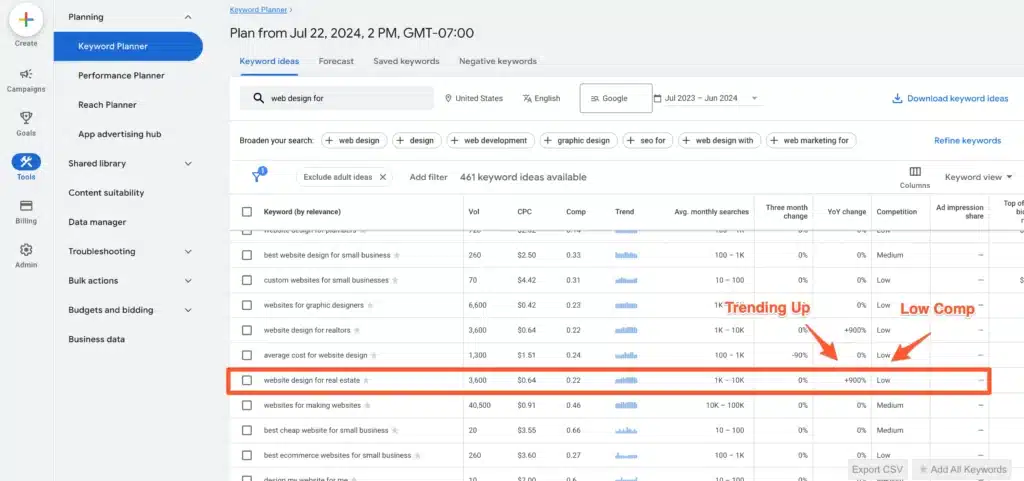
Low and behold I found that the phrase “website design for real estate” had seen a huge increase in volume over the last year but was characterized by Google as having low competition.
So, with just a few clicks of a button we’ve found a contender for a market that might be great to niche down on.
Use Chat GPT for Your Market Research
Another way to do market research is to ask Chat GPT for some help.
The prompt I gave it was:
“I’m writing a business plan for my web design business. Can you do some market research for me? I’d like to know what other web design businesses in my area are offering for services, how much they’re charging, the type of clients they’re serving and any ways I could stand out and be different.”
AND, it had a ton of great data for me to look through.
Now, as with most things AI you have to play with it a bit to get what you really need from it. BUT, it’s definitely something worth fiddling with.
Interview Some Business Owners
Finally, another option for market research is an old fashioned interview.
Call a business owner you know and ask them about their website. Did they do it themselves? If they didn’t, how much did they pay for it? What was their experience?
Try to get a bit of perspective from someone who would actually be willing to pay someone like you to build a website.
It’ll go a long way in knowing how to build your web design business plan.
The Main Goal of Market Research for Your Web Design Business Plan
You want to be able to answer at least 3 questions by the end of your market research:
- What are my competitors doing?
- What gaps will I fill in the market?
- What are the specific details of my customers?
The answers to these questions will help you determine a solid marketing strategy.
After just a little bit of research, you’ll probably start to see some opportunities in the market.
You might find that a lot of web design businesses near you don’t offer certain services that you’d be really good at.
For instance, there might not be anyone who offers copywriting as an add on service to building a website.
Opportunity!
After all, a lot of folks don’t want to have to go to 3 separate businesses to get their website finished. You’d be golden if you busted onto the scene as a one stop shop while everyone around you worked as a piecemeal.
You might also find that there’s a certain TYPE of client that other web design businesses haven’t served very well.
Look through your competitors portfolios and see if there are any types of businesses missing.
Once you’ve done your research it’s time to type up your findings and put it in your web design business plan!
2. Services and Products
Section Summary
- Advice: Specialize instead of offering everything.
- Models: Assembly Line (efficiency-focused), Red Carpet (custom, boutique), and Specialist (niche expertise).
- Flexibility: Start simple and expand as you grow.
Alright, so you did some intense research and you’re ready to make some decisions about what it is you’re going to offer.
It’s here that I see a ton of new web designers throw absolutely everything they CAN do in their service line up:
- Graphic design ✅
- Logo design ✅
- Video editing ✅
- Photography ✅
- Social media ✅
- Web design ✅
- Petsitting ✅
- House cleaning ✅
You name it, they can do it for you. There’s just one problem with that strategy.
Most client’s aren’t looking for you to be able to do EVERYTHING FOR THEM. In fact, it makes you look less specialized which in turn makes you look WORSE to most clients not better.
People are often times looking for THE PERSON or THE COMPANY familiar with their type of issue.
Think about it. You wouldn’t buy a steak dinner from a tire shop.
The more you dilute your offering the more your potential clients lose confidence in your ability to give them what they need.
My friend Gillian talks about how she used to have so many types of offer but then she pulled the plug and brought it down to 1 offer. The result: her business skyrocketed.
That being said, there are TONS of ways to package your service to fit the kind of business you’d like to build.
With web design, there’s no one size fits all.
Everyone is going to have different preferences about things like length of projects or even scope.
At first glance you might think, “we’re all just building websites, right?” Yeah, but there are a lot of different ways to do that.
I like to put the different models into 3 different buckets. Those buckets are:
- The Assembly Line Model
- The Red Carpet Model
- The Specialist Model
Let’s talk about each of them and how they’re different.
Web Design Business Models
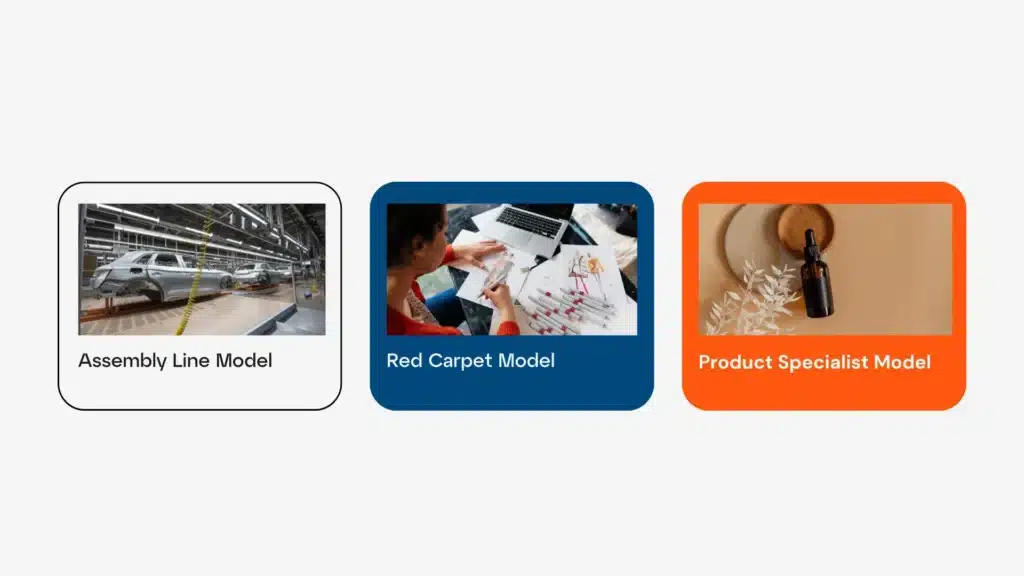
The Assembly Line model is what I like to think of as a website factory.
The Assembly Line Model
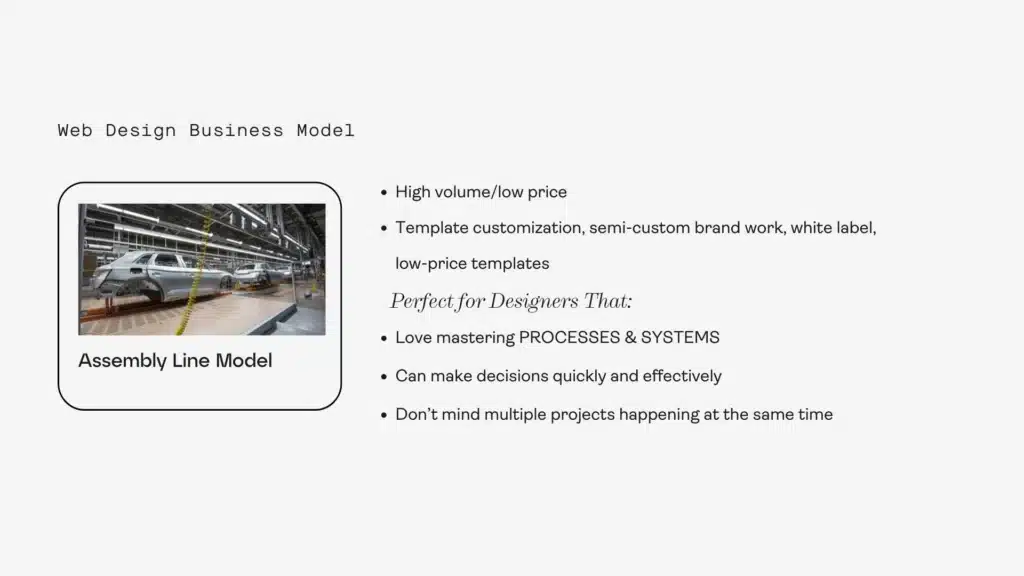
You’re pumping out lots of websites every single month. And, typically, you’re doing it for a lower price point.
Assembly Liners are typically doing template customizations without a lot of work on the more in depth stuff like branding.
So, the client basically comes to you with all the bones of the website (photos, branding, copy). They just need someone to put it all together.
This type of model works well for folks that like having projects with shorter time frames BUT who are also really good at building systems to get a website done FAST.
To pick this model you’ve got to be an efficiency PRO. You’ve also got to be willing to juggle a lot of projects at the same time.
Not that big of a deal if you’re really good at (drum roll 🥁) SYSTEMS!
If you’re the kind of person that loves developing processes AKA you’re an efficiency rockstar, this is the model for you.
The Red Carpet Model
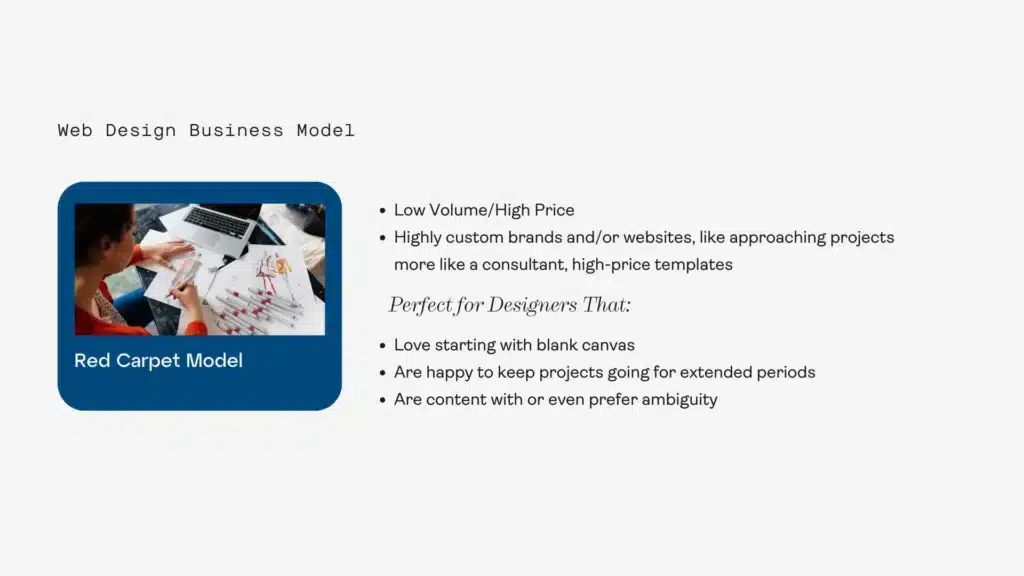
The Red Carpet Model is a more boutique type service.
It’s for folks that want to do fully custom sites with a little bit of extra sauce thrown in for good measure.
This model is perfect for folks that like getting into the nitty gritty with their clients. They like thinking about strategy or branding along with helping them build their site.
And, in general, these folks really like seeing a project go from absolutely nothing to a work of art.
Projects tend to last about a month or more and, generally, you can’t have more than 1 or 2 clients at a time.
You’ll have to charge higher prices with this model because of the fact that you won’t be able to have very many projects going at once.
Because these websites are a little bit higher of a price point, you’re gonna have to bring more to the table that just building a website.
It’s something my friend Lee Blue talks about. You can’t just be a “web designer.” You’ve also got to be a consultant.
You’re helping them grow their business by building a strategy focused website.
Often times, it just takes a little bit of a language curve in how you present what you do. BUT, you’re not looking to bamboozle anyone here.
You’re looking to really help them grow their business through your skills as a web designer.
Some cons on this model are that it’s some times tough to see them all the way through to the finish line.
These projects can drag on for a while which will require you to dole out patience on a level only parents of toddlers understand.
The Specialist Model
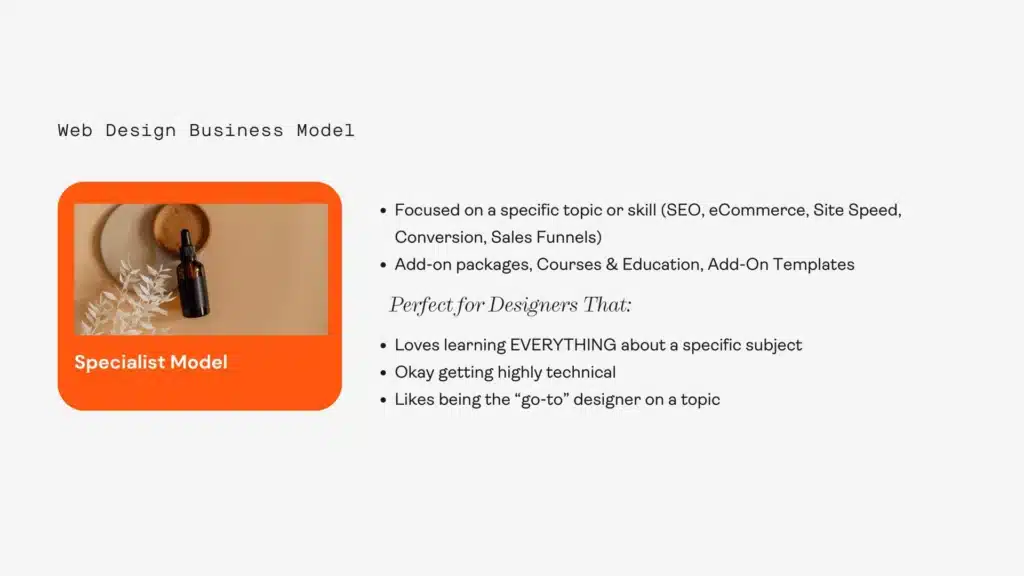
Finally, we’ve got our specialist model.
This model is perfect for your web design business plan if you LOVE getting really nerdy about a specific niche subject in web design.
You become “the guy” or “the girl” everyone points to any time a client has a real specific need.
I’ve seen web designers do this with all sorts of things like eCommerce or site speed or accessibility.
You could even do a sub-niche of a niche topic!
Like, if you want to focus on eCommerce, you could be the go-to person for all WooCommerce projects.
This is really for folks that love knowing anything and everything about a single topic. They’re the kind of folks that could quote every line of a movie or tell you all the intricacies of Star Wars politics.
If that sounds like you, the specialist model is perfect.
What the Specialist Model Looks Like Practically
Projects in this category might not necessarily be a full website build. Some times, you might just come in to do a specific task related to a clients website.
Like if a client wants to add a membership component to their site.
I did this a while ago! Another designer needed help with a client’s site. The client was wanting to have a custom post type created so she could keep her podcast posts separate from her blog post.
So, she asked me to come in and set it all up for her.
I did and it was great. I was in and out of there in like a week and I made about $2k.
Other Products or Services
If that weren’t enough there ARE MORE THINGS you can offer your client that relates to web design.
You could sell them maintenance packages.
You could create templates and sell those.
The list goes on and on. But, again, here’s my encouragement to you. Keep it simple at first.
If you’re new to web design, you might even want to give it a little bit of time before you start to pick a model and really hone in on it.
You just won’t know what you’re preferences are until you’ve got a few projects under your belt.
But, eventually, you’ll start to notice things you like doing and don’t like doing.
Over time, you’ll also start getting really good and getting things done. You might also hire on help. Then you can begin to think about expanding your products or services.
But, don’t be afraid to take it slow and figure out what works for you.
3. Income Goals
Section Summary
- Income Goals: Use S.M.A.R.T goals to set specific, measurable targets.
- Strategy: Calculate monthly and per-project income needed based on chosen business model.
Before you start building out your marketing strategy you need some kind of general income direction you know you want to head in.
Without an income goal you want know just how much marketing you need to do.
I once heard Dave Ramsey talk about how one of his young sales employees told him he wanted to be the best salesman in the company.
Then Dave asked, “Okay, so what’s your plan?”
The guy didn’t have one. He just knew he wanted to be the best. Dave decided to help him.
He asked him how many calls he had to make in order to get one sale.
Then he asked how many sales their top salesman made.
Then he broke it down. If he wanted to make the same number of sales as the top salesman, he’d have to make at least so many calls every year, so many calls every month, so many calls every week and so many calls every day.
The young gun had his strategy. But, he wouldn’t have known any of that unless he asked some of those other questions first.
Similarly, a lot of web designers I know say things like, “I just want to make as much money as possible!”
That’s great. I love your enthusiasm BUTTTTTTTTTT how do you know your plan is working with a goal like that?
When do you know you’ve hit, “as much money as possible?”
You don’t. You never will. As soon as you make a certain level of money a new “as much money as possible” level will open up.
You ever heard of S.M.A.R.T. goals? It’s an acronym that tells you your goals need to be:
- Specific
- Measurable
- Achievable
- Relevant
- Time-bound
Get the acronym? S.M.A.R.T?
We won’t worry about those last 3 for now. The thing I want us to focus on is the Specific & Measurable part.
To do that we need the Web Design Business Plan Income Equation. WDBPIE for short…okay that doesn’t work nearly as good as SMART goals but I’m trying here.
How to Create a S.M.A.R.T. Goal for Your Web Design Business Plan
The idea is simple enough. You take the yearly income you’d like to make then you divide that by 12. That will give you what you need to make every single month in order to hit your yearly income goal.
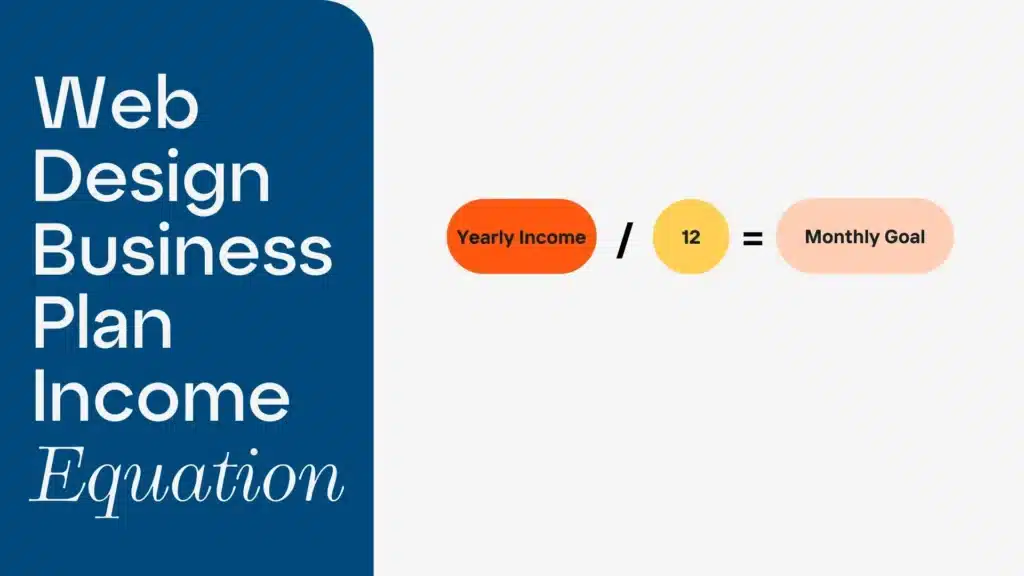
So, if your yearly income goal is $100,000 you divide that by 12 and it gets you roughy $8,344 dollars that you need to make every single month.
If it’s $150,000 you need to make on average $12,500 every month.
$200,000 you need to make on average $16,667 every month.
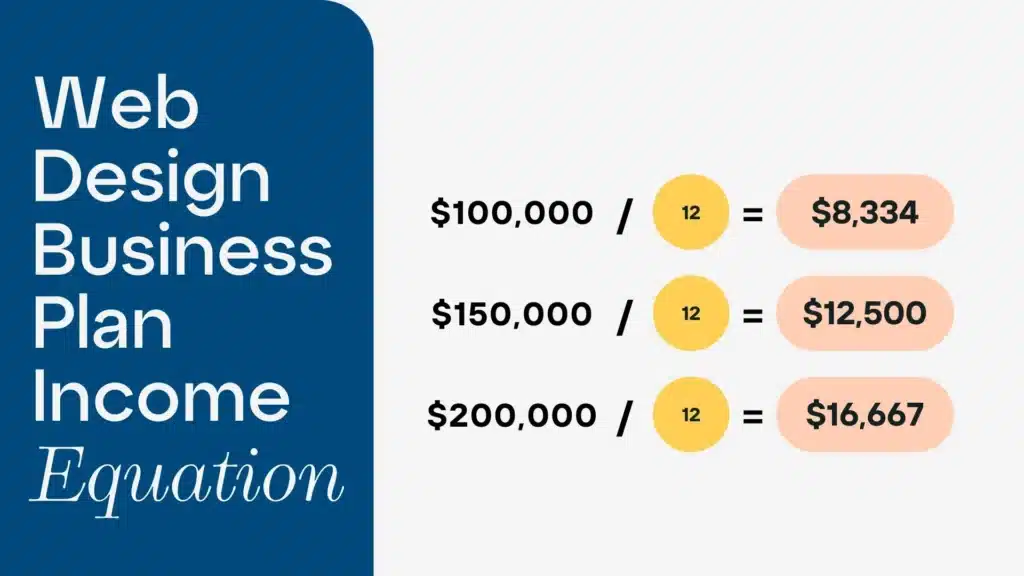
But, that’s still not specific enough. There’s a lot of days in a month. So, we need to dig even further.
We need to take that monthly goal divide it by the amount of projects we want to take on each month and get a general idea of what we need to make per project to meet our web design business plan.
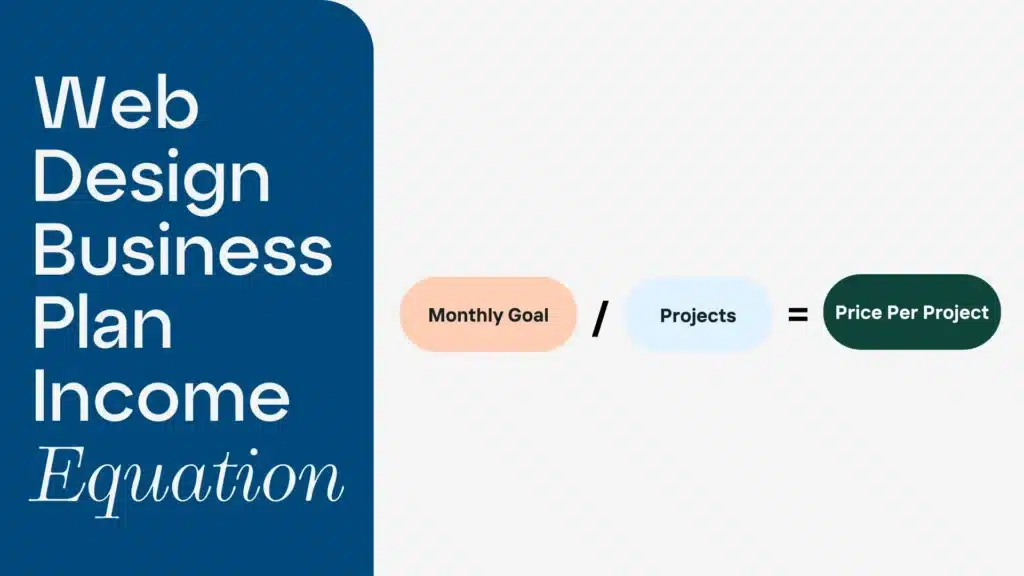
At this point you’ve got to reference the business model you’re planning on using. Because, as you’ve probably realized from doing some market research, prices can vary DRASTICALLY from one company to the next.
Let’s do the same thing Dave Ramsey did with his young sales man.
Let’s say your goal is to hit $100,000 as a web designer. Congrats! You’re a 6 figure web designer.
We know that to do that we need to make $8,334 each month.
If you choose the Assembly Line Model you’ll need to do anywhere from 4 to 10 websites a month. AND, let me be honest for a second. Doing 1 website every week is pretty tough for a single web designer.
So, you take $8,334 divide that by 4 websites a month and you get a per project price of about $2,100.
See how this works?
Okay, now lets try the Red Carpet Model. You’re doing highly customized sometimes from scratch websites.
A single web designer will be able to do 1 MAYBE 2 of those a month.
So, if you’re doing 2 sites a month, you need to make roughly $4,200 per website in order to hit your income goal.
What if You’re Not There Yet?
At this point, you might be discouraged. ESPECIALLY, if you’re new to the world of web design.
When I was first getting started earning $4,000+ for a website seemed like an impossibility. But, then, one day, it happened.
Just because you’re not there yet doesn’t mean you won’t ever get there.
But, I can tell you that if you don’t have a web design business plan in place TO get you there it will take you MUCH MUCH longer.
Sometimes, you got to keep your head down and work the plan until something finally budges.
Until some day even a $4,000 website feels like a waste of time 😏
4. Marketing Strategy
Section Summary
- Marketing Funnel: Attract leads and nurture them to conversion.
- Methods: Network marketing (relationships) and content marketing (visibility).
- Networking Tips: Join groups, masterminds, conferences, and meetups.
- Content Marketing Tips: Find a channel you enjoy creating for and focus on that.
Okay, so, you’ve got a S.M.A.R.T. goal for your income along with the type of model you’re gonna choose for your web design business plan.
Now, we need to figure out the whole marketing strategy deal.
The best way I’ve found to think about marketing strategy is in terms of what’s called a Marketing Lead Funnel.
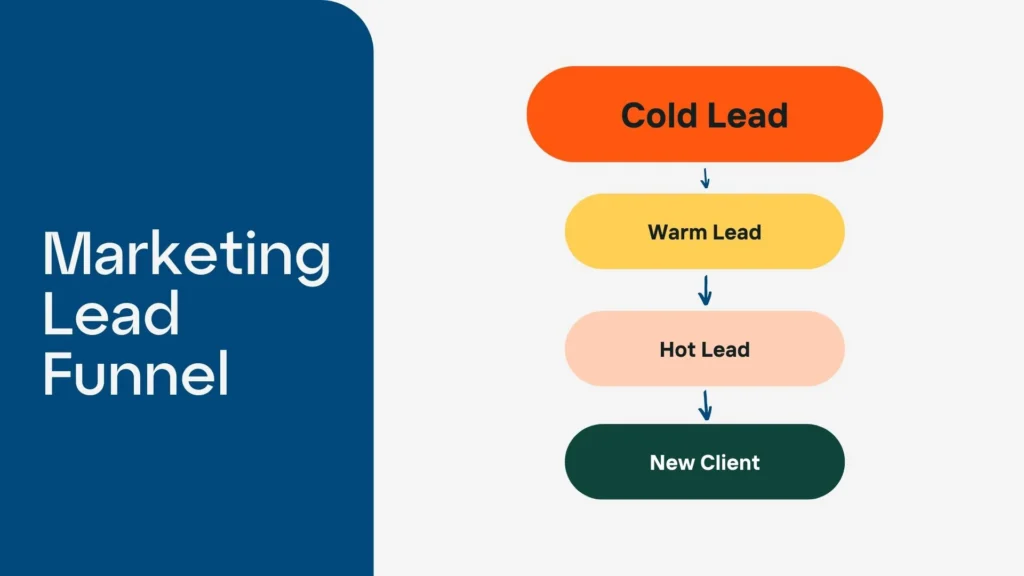
A marketing lead funnel takes people through the process of being a cold lead, someone that is aware of what you do and has a need that relates to it, all the way to a new client.
So a complete marketing strategy for your web design business plan is to attract the cold leads and then nurture them all the way until they become a client.
Sometimes that process happens quickly. Sometimes that process takes time. You’ve got to think of folks along every step of the journey if you want to keep from losing them in the funnel.
How do you do that? Great question let’s dive right in.
Attracting Leads
The first step in the funnel is just getting people to notice you.
Folks are already aware of the problem they have (they need a way to market their business online). They’re aware of the solution that can help (a website will allow them to market themselves online).
They’re just unaware of the solution you provide. So, in marketing guru speak we’re trying to make them “product aware.”
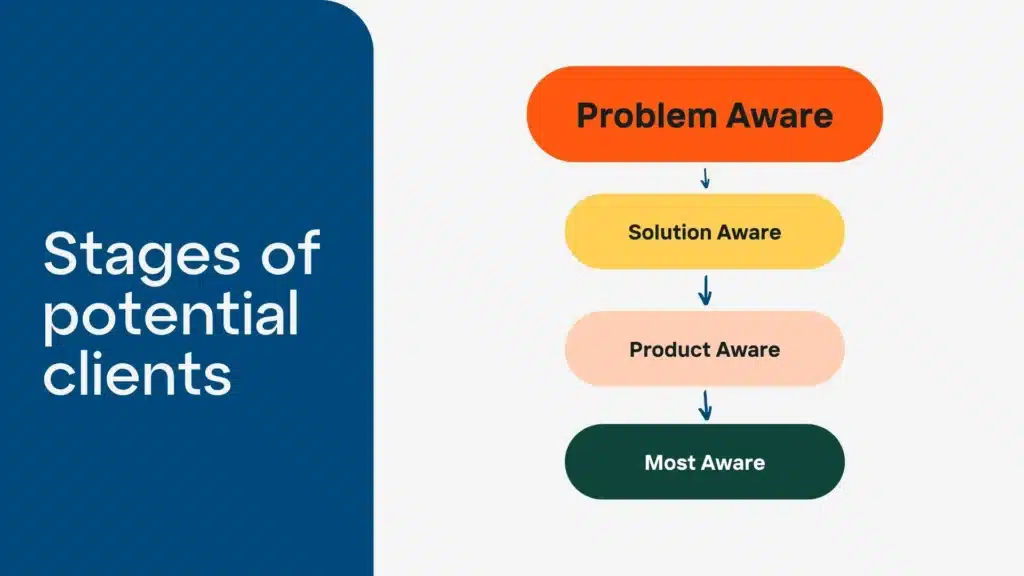
How do we do that? Lot’s of ways!
But, really most of the methods can be boiled down to 2 main categories.
- Network Marketing
- Content Marketing
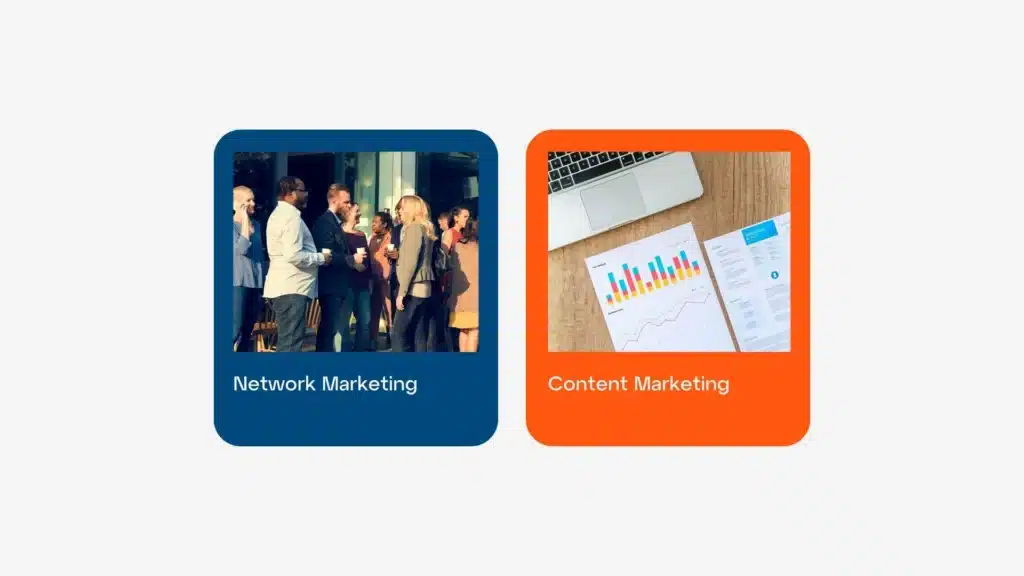
Network Marketing
Network marketing is the OLDEST WAY businesses have been able to find and nurture clients. Don’t fact check me on that. Maybe folks were doing something else back in the dark ages but my guess is it was all about the people you knew and the people who knew those people.
Plain and simple, network marketing is leaning on relationships to sell a product or service.
And, it can be one of the most effective ways to nurture a client.
Think about it. You go from a cold lead to a very warm lead if someone you trust tells you about how much they loved a product or service.
No need to test the waters. No need to investigate further. Just shut up and take my money.
The problem most people have with network marketing is they start to feel like used car salesman.
No one likes the feeling that the real reason someone is reaching out or trying to connect with you personally is because they’re trying to sell you something.
Believe me I’ve had so many friends just “check-in” who were actually wanting me to sign up for their new MLM gig.
Don’t get me wrong. I actually don’t even mind it. I don’t turn off ads on Instagram. If you’ve got a cool product that is worth my attention I don’t mind you trying to sell to me.
But, it does make most folks uncomfortable AND it might be really tough for you to try to find and nurture new web design clients this way.
There’s one antidote to that:
Don’t look at people as dollar signs
Approach every relationship trying to be helpful FIRST and in general just be a good friend.
With every person you meet you need to ask yourself, “how can I really help this person succeed in what they’re trying to accomplish?”
NOT, “how can I make this person my client?”
At this point, the objections I get about this approach are something like, “but, if I’m too helpful they won’t hire me.”
I’ve just never found that to be true. I’m more often told things like, “I don’t want to take advantage of your generosity.”
People kind of have this meter in their brains for when someone is being helpful for something they could be charging for. When that meter gets to high they start to notice and will back off.
I love the Zig Ziglar quote: “You will get what you want in life if you help enough people get what they want in life.”
Plus, you’ll really quickly start to notice when someone is just taking advantage of your good will. Then you can pull the plug.
How Do You Network as a Web Designer?
Okay, so are you feeling better about networking to find clients? Cool. Here’s how you do it.
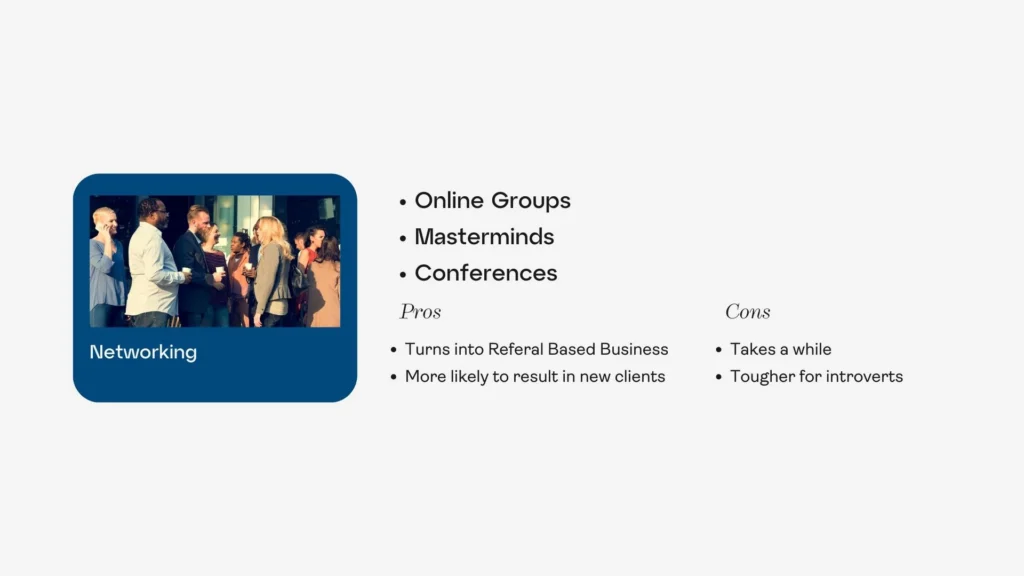
There are basically four places you can network as a web designer:
- Groups
- Masterminds
- Conferences
- Meet ups
So, your job is to find events or groups in your area or online and go and talk to people.
And, before you say, “but there’s nothing around me like that!” Have you looked very hard?
Checkout websites like Meetup. Google “chamber of commerce” in your area. I think you’ll be surprised at just how many opportunities are out there.
Of course it doesn’t feel that way at first. You were’t looking for them!
But, you’ll definitely start to notice them more and more as you look for them. AND, you can ask some friends if they know about any events.
In just a little bit of time you’ll have more events to go to than you have time for.
Online groups or masterminds are a great option as well! Try to find where your customers are hanging out and then go hang out with them there.
Showit has a facebook group for our users with 14,000+ people in it. Designers are on there all the time being helpful and connecting with folks.
From what I’ve seen, the ones that are the most helpful end up being the most successful 😉
Content Marketing
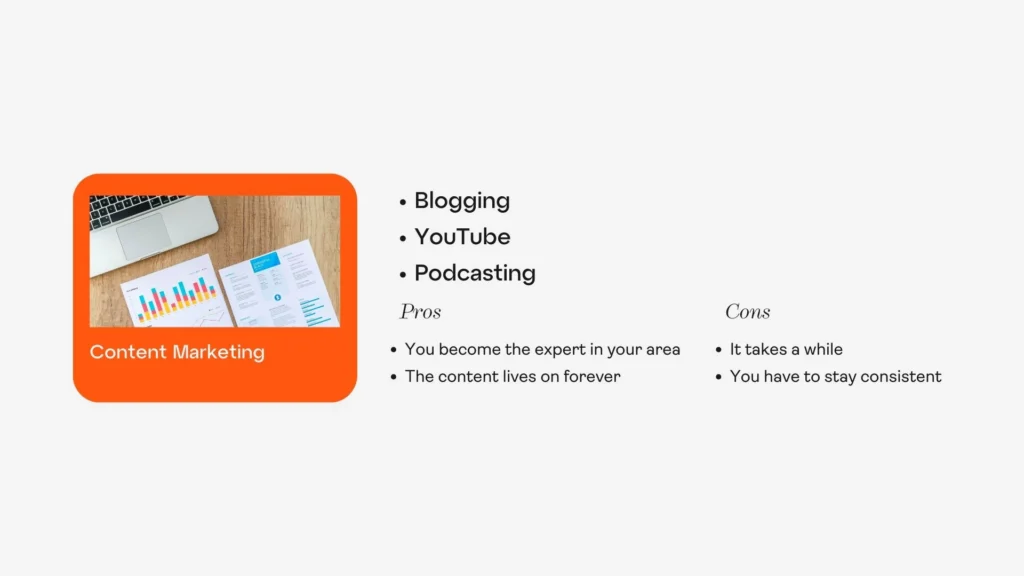
Content marketing is what it sounds like. You’re making content that helps your potential clients with the problems they face.
The cool thing is as you grow your authority in the space you start to become the sought after expert. So, people find your content are impressed by your knowledge and say, “shut up and take my money!” 😂
Most people when they hear “content marketing” think social media. BUT, that’s just the very tip of the iceberg and probably one of the toughest forms of content marketing.
There’s also things like:
- blogging
- podcasting
- youtubing
- AND newsletters
The key here is to find something that you enjoy doing and lean into that ONE THING until you get it mastered.
I’ve seen so many people stretch themselves thin over all the different avenues of content marketing. That’s just not sustainable.
Most big companies that do that have teams and teams of people focused on just one channel!
So, pick one and really start to master it.
Another question that comes up is, “how do you know what content to make for content marketing?”
Thankfully, there are tons of resources. One my favorites is a tool called “Answer the Public.”
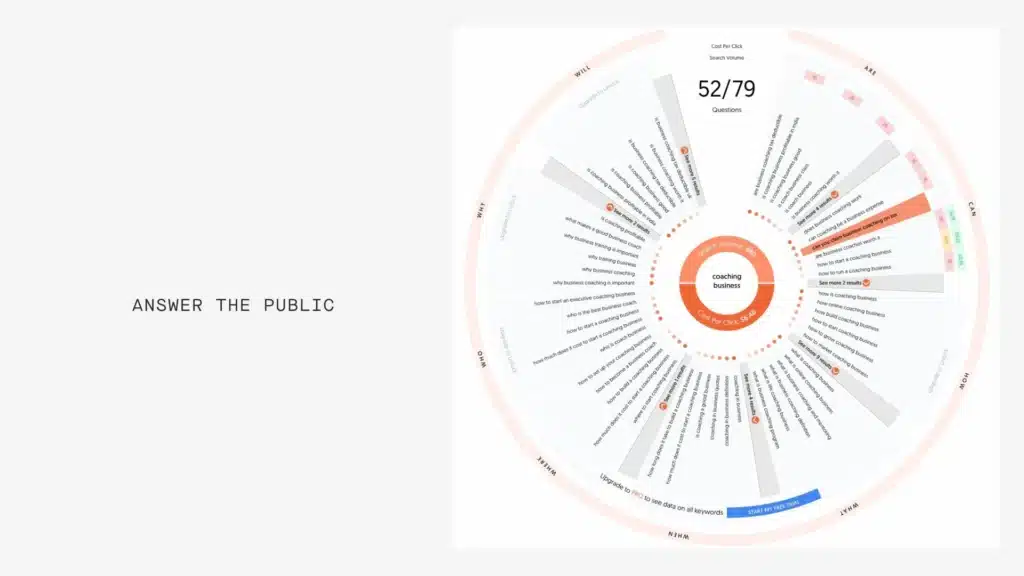
You go in, enter a topic and it’ll spit out a list of tons of things people have searched for regarding that topic.
So, a good strategy would be to take that list and make sure you have a single piece of content for every single question.
Eventually, you’ll start to intuitively know the questions that people have because you’ll be interacting with them on the regular. But, there are always helpful tools to fill in the gaps until you get there.
Other Options
As if that weren’t enough, there are even more options for your marketing strategy in your web design business plan. I’ll touch on them briefly.
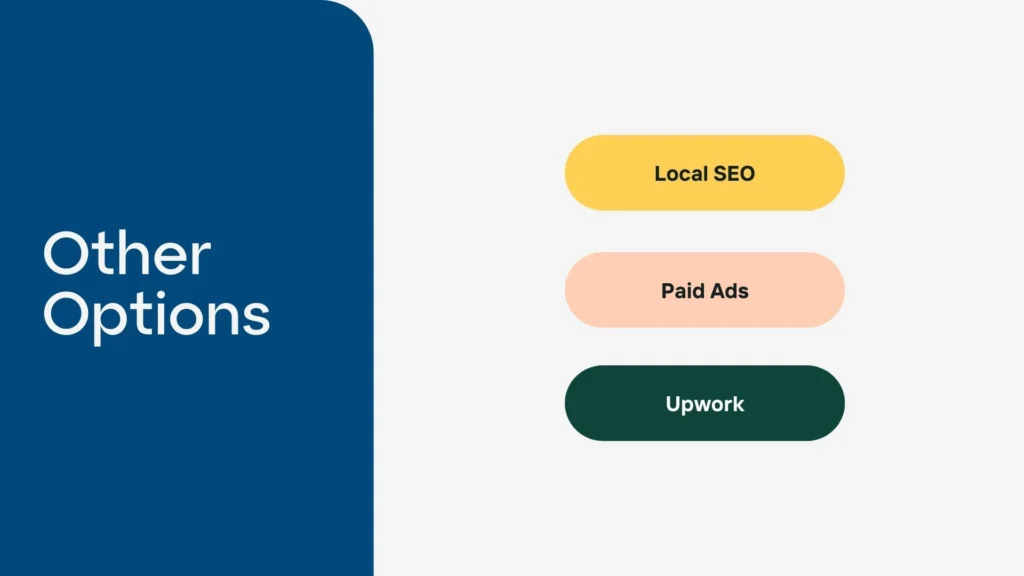
If networking or content marketing doesn’t sound enticing there’s also
- Local SEO
- Paid Ads
- Freelance marketplaces like Upwork
Local SEO is using tools like Google Business to make sure the people in your area know you exist. If you spend a little bit of time updating office hours, adding photos and getting clients to leave reviews it can go a long way.
Paid ads use search engines in a similar way to an SEO strategy would BUT instead of hoping a piece of your content shows up in front of the right people you’re paying to make sure it does.
Typically, you’ll set a dollar amount for how much you want to spend in a given period of time. Then you’ll figure out a way to target the kind of people that would be interested in hiring you.
Paid ads can be competitive AND if that’s the only method of marketing you use you’ll likely always need to pay for ads in order to get new business. But, for some folks that’s just fine!
I know plenty of businesses that get all of their new clients through Google Ads. So, definitely a viable option.
Finally, there are platforms like Upwork where potential clients post jobs and you can go and bid on those jobs along with other freelancers on the platform.
Upwork was a HUGE part of my success as a web designer. So, I kind of hate when people dog on it. You might love it, too! So, don’t dismiss it just because you heard one person say they had one bad experience.
Give it a shot.
Wrapping Up Your Marketing Strategy for Your Web Design Business Plan
Alright! Those are all your options.
Now, you’ve got to take all of that and come up with a strategy that will work for your web design business plan.
It might be tough at first especially if you’re new to the game. So, the best thing to do is pick a strategy. Try it out for a few months. Evaluate it and then decide if you want to keep going in that direction OR if you want to try something else out.
If something doesn’t work it doesn’t mean you’re doomed to failure. It just means you need to try something else.
Keep growing. Keep adjusting. You’ll figure it out!
5. Executive Summary and Company Description
Section Summary
Executive Summary
- Purpose: Outline the business’s mission, target market, and financial goals.
- Content: Summary of services, unique value proposition, and projected growth.
Company Description
- Overview: Details about the business including all it’s employees, its mission, and the problems it solves.
Now that you’ve done all that work the other sections should be easy breasy.
All that’s left is your Executive Summary and your Company Description.
An Executive Summary is the cliff notes of all the other sections of your web design business plan. You take all that information and compact it into a few paragraphs.
That’s for folks that just want a quick glance of your company. They don’t need to get into the weeds of it all.
So, you want just enough information that it lays out your plan and strategy BUT not so much that it goes into the granular detail of it all.
Then, your Company Description is a list of everyone in your business, a mission statement, and the type of business it is like an LLC or Sole Proprietorship.
Again, those sections aren’t anything that should take a ton of time once you’ve done all the work for the, research, services and marketing strategy sections.
6. Don’t Forget Your Nonnegotiables
Section Summary
- Work-Life Balance: Set boundaries to ensure personal time isn’t compromised by work demands.
- Client Compatibility: Only work with clients who align with your values and work style.
- Pricing Integrity: Establish fair pricing and stick to it, avoiding undercharging.
- Quality Standards: Maintain high standards for your work, never compromising on quality.
- Continuous Learning: Invest in ongoing education to stay updated with industry trends and skills.
Something I want to mention that doesn’t get a lot of attention when it comes to building your web design business plan is something I call your nonegotiables.
Here’s the truth. It won’t matter how quickly you scale up your business if you hate what you do and who you do it for.
So, you need to set some rules and boundaries that safe guard you and your business from going in a direction that you don’t want it to go in.
Someone I follow calls it his “Not To-Do List.”
If you don’t write that list then other people will write it for you AND you’re probably not going to like it.
So, start by figuring out where your boundaries are.
How to Figure Out Your Nonnegotiables for Your Web Design Business Plan
Here are a few questions to ask:
- How many hours do I want to work?
- How much money is enough in this season?
- What types of projects will I NOT do?
Those are a few to get you started. As time goes on you’ll be able to ask yourself even better questions like, “What does my ideal client look like?”
A friend of mine that I had on the podcast talked about how after a few years of building his agency he realized that about 20% of his clients were a nightmare to work with.
So, he did something most of us would have a tough time doing. He fired those clients.
But, a funny thing happened. His business grew even more after that.
He and his team were able to spend more creative energy doing projects they loved doing.
Sure, you might have to suck it up at the beginning and take on clients that aren’t a part of some kind of web design daydream you have when your mind wanders.
But, a big point of a web design business plan is to make sure that you don’t stay in those seasons for very long.
Wrapping Up Your Web Design Business Plan
Section Summary
- Final Advice: Regularly update your plan, be adaptable, and focus on long-term sustainability.
Okay, you’ve got all the tools and information you need to make your own web design business plan.
I know this is a lot of information. But, your business plan SHOULD PROBABLY take you a little bit of time to put together.
You want something that makes you pause and question. That way you know you’re stepping into the next season of your business thoughtfully.
So, take your time putting it together, but then, just go for it.
I’ve so often seen people stay in the planning stages of their web design business. They’ve got amazing ideas on how to build their business. They just never do anything about it.
After all your planning and prepping make sure you do the most important thing for your web design business: take the first step.

Comments